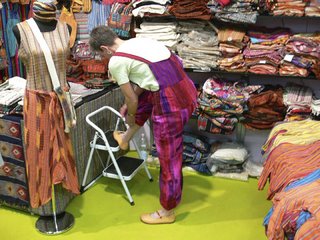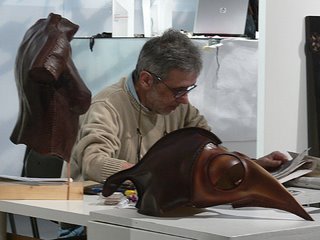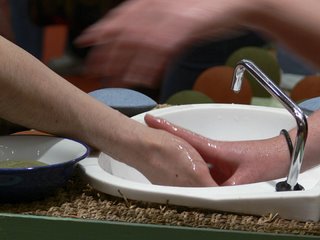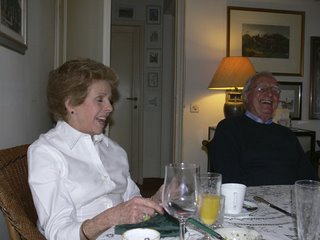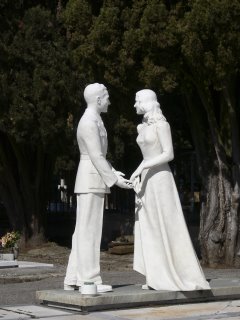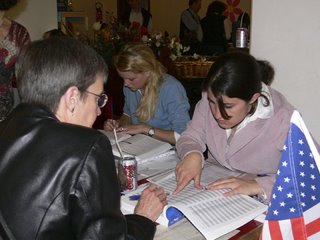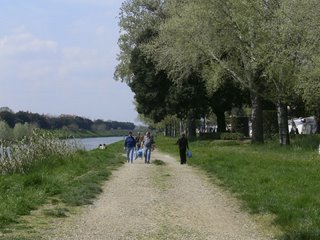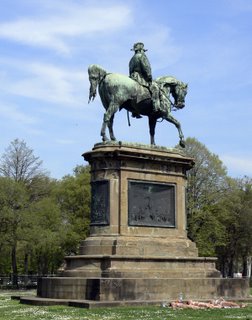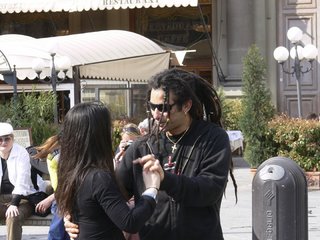
It certainly is a strange world sometimes and it’s funny how some things which appear fairly meaningless fulfill some kind of destiny all their own.
Take Savonarola for example (that's him in the photo).
On our very first trip to Florence, more than 12 years ago, we stood on the very spot where Girolamo Savonarola, the Medici-hating, reformist, fanatical monk was burned alive along with two associates after a short spin as head of Florentine government. Now cut to the winter of 2006. On our first outing in Florence in early February we stopped at the church and monastery of San Marco to see the work of Fra Angelico and also visited the very cell where Savonarola was living and working when he was dragged out to be tried, convicted and burned at the stake.
And then this past Friday, April 7, we stood in front of the house at no. 19 Via Savonarola in Ferrara, Italy, where Savonarola was born and lived the first twenty years of his life – and is now used by the local university as a theater for students to present just the kind of art which would of course have the old monk spinning in his grave, except that his grave is the depths of the Arno river.
Lest you interpret all this as some sort of hero-worship, when it comes to burned monks, I much prefer Bruno Giordano who was burned at the stake for heresy; he believed that people should be allowed to make up their own minds about things, not a welcome idea among the church faithful at the time. His statue sits squarely in the center of the Campo d’Fiori, one of our most favorite piazzas in all of Rome – and where he was executed.
Given short shrift by most of the “mass market” guidebooks, Ferrara, about 30 minutes north of Bologna and 90 minutes north of Florence, is a gorgeous city in the Po delta complex and worth a long day trip or perhaps an overnight. And just to the north is Padova and then Venice; to the west and north and easily reached by train are Verona and Mantova. And since Ferrara sits right on the main train line from Bologna to Venice getting there is no problem.
We took an 8:47 train on a beautiful, sunny but crisp morning from Florence and after a brief stop in Bologna pulled into the Ferrara station a little after 10:00 am; our return wasn’t until nearly 7:00 pm so we had plenty of time to explore the historic city center. (Note: there is construction at the station and the bathrooms, “WCs”, have been temporarily relocated to the portajohns next to the bar – with your back to the tracks go right around the station and voila.)
From the train station to the historic center was an easy 15-minute walk. Out of the station we turned left and then followed the curving boulevard around to the right until we passed through the old city walls. Although not as dramatic as, say, the walls that encircle Lucca, Ferrara’s city walls pretty much ring the historic center and you can walk them with ease. (Bicycles are also very popular here as well.) They also appear to provide a reasonably good elevation from which to view the city.
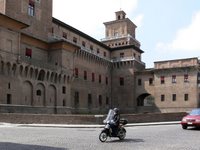
After passing through the walls we came to Viale Cavour and took it straight to the Castello D’Estiense (open Tues-Sun, 9:30am-5:30pm; admission), at one time the home of the powerful Este family who ruled this area and which is now mostly administrative offices, an art gallery and one of the two tourist offices in the city.
But before doing anything else we needed refueling and so we stepped across the street from the castello to the “Art Cafe” (Via Borgo del Leoni) to have a macchiato and dolci while taking in some of this new place.
After we left the café and re-crossed the street we crossed the moat and entered the castle. (A moat? That’s right you medieval fans, they have a real, filled moat with drawbridges for both foot and wheeled traffic and they still work!)
We were all ready to go inside when we found ourselves caught between two large Italian school groups whose teachers were bound and determined to show their students history and art together and so we decided to come back later. In fact Italian school groups are out in force everywhere in Italy this week, particularly since nearly all of the state-run museums in the country are free, a fact we would turn to our advantage on this trip as well.
So we strolled across the courtyard of the castello to the TI office where we picked up a map of the city and plotted out our course for the rest of the morning.
There is actually quite a bit to see and do in Ferrara but our approach to traveling has always been to stroll and take in the city itself, maybe drift into an art gallery or museum if it strikes our fancy, but see the city, watch the people, have coffee, sit down and relax from time to time. Eat a meal.
And of course see the cemetery.
Curiously the enormous “cimitero monumentale” in Ferrara takes up a very large tract of land inside the city walls and, as we would soon discover, was a place for strolling, bike riding as well as connecting up with the past of the city.
So we left the castello and headed north up the Corso D’Este, along wide sidewalks, and very wide cobblestone streets and past meticulously maintain ed low row houses full of color and many with spring plants already out, all very reminiscent Susan thought of Colonial Williamsburg.
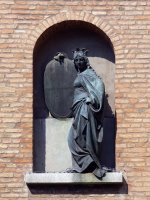
Along the way we came across the Museum of the Risorgimento (“resurgence”) and Resistance in Ferrara. (The Risorgimento was the beginning of Italy’s quest for independence and unification in the 19th century. We had seen much of this as well at the awesome and powerful monuments and ossuaries at the Solferino battlefield last year when we stayed near Lake Garda.)

We walked inside and immediately saw the sign, “ingresso gratuito”, “entrance free.” A very nice woman met us at the door and handed us a guide in English (it is so obvious we are not Italian) and in we went.
The museum is not only for the tourist and traveler but a fine resource for the serious researcher of Ferrara’s role in the history of modern Italy as well. They have a wonderful research collection, much of which is out and available to the public for viewing, things such as newspapers, posters, photographs, etc., all arranged chronologically, and easily to find your way from one time period – one conflict if you will – after another.
The museum has a wonderful collection of uniforms, arms, and numerous other artifacts and items covering pretty much all the major periods of resistance in modern Italian history. Since northern Italian was the fulcrum of the resistance movement during World War Two, it is not surprising that you would also find a large collection of truly fascinating materials from the resistance to German occupation. All of the halls and materials are very well marked, although in Italian only (excepting the guide). The Comune di Ferrara operates the museum. (Open Tues-Sat. 9am-6pm; admission.)

From the museum we turned left back on the Corso D’Este and continued our walk north toward the cemetery complex. We passed a lovely park – indeed there is so much green inside the city walls today – and watched a sight so typical of Italy: a woman obviously keen on fashion and style, yet having to wear a bright orange jumpsuit as part of the uniform of a landscape worker.
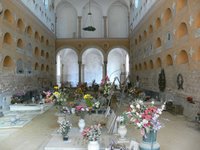
We eventually found ourselves in the cemetery and were immediately struck by the sweeping arcades, the sheer volume of flowers, fresh and otherwise, the unique side-crypts with their dirt floors and wall niches ready for the next urn (yours or mine), the almost city –like feel for this huge complex was itself overwhelming.

While the statuary and mausoleums lacked the power and artistic impressiveness of the Porte Sante in Florence, we did come across something unique in our experience: rosemary bushes as a burial plot decoration.

It appears that within the past year or so there had been a large reorganization and exhumation and subsequent re-inhumation of a large number of bodies. What appeared to have been open broad expanses of land between the sweeping arcades have in effect been turned into new burial grounds for these “re-inhumations”. There are large tracts of burial grounds dedicated to what appears to be plots of land for “cremains” as I think they are called. And each of these very small plots has a stone and then is decorated with a large rosemary bush! And when you add in the flowers from the families and friends the entire scene is a feast for the senses.
After strolling in the cemetery for an hour or so we left and headed to the nearby Jewish cemetery which although appeared close on the map we had to go in a rather roundabout fashion. This was a good thing though. Ferrara has set aside a large amount of land inside the walls for gardens and a nice walking park, all designed to try and recapture a flavor of what this part of the city was like more than a half a millennia ago when it was largely used for cultivation of one type or another.
Anyway the entire experience made us feel as if we were out on a stroll through the countryside and it was hard to imagine we were still inside the city. After wandering around this wonderful country looking for the Jewish cemetery we finally stopped to ask directions to the “Cimitero ebraico” from a postal carrier.
Ten minutes later we were standing in front of this enormous gate, and at the suggestion of a workman just closing the gate behind him we rang the bell. We were soon met by another very nice older woman who showed us inside, had us sign the guestbook (no names from outside of Italy we noted), and after she placed a yarmulke on my head we strolled through a small door into large expanse of open field that was, well, mostly empty.
There were several burial plots all of which were near the gate: flat stones as well as several mausoleums representing families of course. The “Cavalieri” monument, however, was particularly striking, flanked by two powerful eagles, it was dedicated to Pietro, Giuseppe and Clara. Pietro had been awarded the silver medal presumably for bravery while Clara had been awarded the gold medal.
To add further to the mystery Clara was listed as a member of the “P.I.”, possibly the partisan organization in Ferrara and after her name in large letters was the word “Archivolti”, an architectural term in English it is Archivolt, and means “a band of molding, resembling an architrave, around the lower curve of an arch.” She died in 1945 presumably during the war. Their stories of strength and heroism in the face of overwhelming odds are only hinted at in the few words etched in stone and one can only wonder are there people still like that here today?

After we paid our respects at the Jewish cemetery we headed south back toward the center of town, took a break in the Piazza Aristeo (that's it in the photo) and then pushed on toward the castello and the medieval quarter. We skirted to the left of the castello and strolled down Corso Martiri della Liberta’ (Street of the martyrs to liberty”, and rather coincidental given where we had just been) to the Piazzale Cattredale, the city’s central Duomo across from which is the Palazzo Muncipale, the seat of local government.
On the ground floor of the Palazzo is the Café Leone D’Oro where we stopped for lunch. Susan had a tasting menu, six small portions of some of the local specialties, a couple of cheeses, polenta, a gratin and a small group of local mushrooms in a light sauce. Tasty. I had the pasticcio, a pie filled with pasta and béchamel sauce. Man oh man was that good.
After we relaxed over coffee and enjoyed just being alive and in Italy we left the café, turned down the tiny Via Adelardi, just to the left of the Duomo entrance and headed off to explore the eastern side of the historic part of the city. In particular we were off to pay our respects to one of history’s icons of controversy, Lucrezia Borgia.
Via Adelardi becomes Via Voletapaletto, which soon becomes Via Savonarola and just after passing the church of San Francesco, we turned right down Via Pergolato. About 100mts down the street on the right hand side is a small nondescript door with a sign informing us that the monastery church of Corpus Domini, where Lucrezia and a number of other Este family members are buried, is open from 9:30am-12 and then 4-5:30pm (no admission, donations welcome). Lucrezia had been married to Alfonso I, one of the Este dukes. Since it was only a little after 3:00 pm we decided to stroll toward the eastern side of the walls and then come back when the church reopened.
We retraced our steps to Via Savonarola, walked past his house – one cannot help but remark on the fascinating physical closeness between these two controversial and much maligned figures from the middle ages – and walked to the walls, strolling past a large abandoned military complex.
The walls today are impressive from the outside, at least in some places, but from the inside resemble just a small bit of hill, which seems to have been strategically placed to simply cut down the view to the horizon.
We returned westward, this time going back along Via Scandiana, where one can easily see the more egregious effects of the military installation abandonment. Odd given that the city seems so orderly and clean and neat otherwise.
Anyway as we were walking down Via Scandiana we came upon Palazzo Schifanoia (“SKEE-fah-noy-yah”), one of the grandest of the Este ducal palaces. The singular reason for stopping here is to see the “Room of Months.” Located on the upper floor this enormous salon is truly spectacular. The walls, probably 30 feet high, were at one time totally covered with court scenes and those that remain (which have been carefully restored) are absolutely stunning. Breathtaking I think would be an apt term here.
As you leave the palazzo go out the back and there you will find a gorgeous picnicking area with a bar and bookshop in the back garden; a wonderful place to relax. And they make a point of prohibiting school groups from sprawling all over the grounds. That’s a plus right there. (Via Scandiana, 23, open Tues-Sun 9-6; admission.)
It was a little after 4:00 pm when we left the Palazzo Schifanoia and so we he headed back to Corpus Domini. When we got to the little door it was locked so we rang the buzzer. A woman’s voice asked us in Italian what we wanted and we said we wanted to see the tomb of Lucrezia Borgia. She (the woman not Lucrezia) asked us if we spoke Italian. We said yes, a bit. She then instructed us to go around the church and she would let us in through the main door to the church.
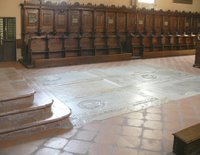
So we walked around the corner onto Via Campofranco and used the large knocker on the door. While we were standing there waiting for something to happen an older gentleman was watching us from halfway down the block. When I glanced down his way he would smile and wave for us to stay put. He stayed there while we stood in front of the door – I would glance back, he would smile and wave. This seemed to go on for some time and then we heard the magical sound of the door being unlocked from somewhere off in the recesses of the church. We walked in through the vestibule and to the left a bit off along the wall of the small church was an aged nun, hunch-backed behind a wall of bars who told us to close the door and come in. She then pointed to a door at the far end from where we were standing, around the corner of the altar and motioned for us to go through it which of course we did. (She’s a nun after all, you have to do what she says.)
We came into a small chapel directly behind the altar of the little church and on the far wall was another small set of bars behind which the nun remained and told us to look in the center of the floor. Sure enough there were six marble slabs, two rows of three, and our hostess commenced to tell us who was in each one. Lucrezia’s tomb was in the “center of the top” row, nearest the steps to the wall and she was in fact buried with five other people: her husband Alfonso I, Eleonora of Aragon (mother of Alfonso I, I believe), Alessandro, son of Lucrezia and Alfonso, Lucrezia’s infant daughter Isabella, and Alfonso II, the last Este duke. (Of course their remains are in the crypt below, a place that I would have liked to have seen but felt it would have been out of the question for me to ask.)
After our guide finished her story we she asked us if we knew who Mary was, the mother of Jesus. We said yes we knew who she was. She then gave us a tiny medal clipped to a safety pin and informed us it would protect us. Naturally we left a donation.

We left the church and continued our stroll through the medieval quarter eventually working our way back to the Piazza Cattredale, and the center of the historic downtown, where there were campaign speeches and songs blaring to keep reminding us that this weekend is the big vote for Italy. But for us we just walked, window-shopping, and just watching the people go about their lives. We peeke dinside the duomo just as mass was getting underway.
A little before 6:00 pm we started to head back to the train station. We caught the 6:47 train, which was on time and found ourselves back in Florence by 8:30. We strolled home and by 9:00 pm were back in the apartment where we decided to just relax for the evening.
General impressions:
Parking and driving is a breeze, or so it appeared to us and walking did not require any particular survival skills. Although we missed a number of recommended venues for art I would recommend you grab a good guidebook and check things out for yourself. (We used the Rough Guide to Italy.) And certainly stop at the TI office before beginning your local trek. Oh, and it would appear that like many other parts of Italy most museums and attractions are close don Monday.
Food costs are quite a bit lower than in Florence of Tuscany and I suspect that may also be the case for lodging but not certain on that point.
Ferrara is clean, quiet, orderly and more akin to the kind of place we would feel most comfortable in spending the next few years of our lives. No tourists, or rather very few, and virtually no dog poop or pigeon droppings either. It would be a great place to break up a trip wedged between the intensity usually experienced by the harried traveler to Venice or Florence.
Anyway, for additional photos from our recent Ferrara day trip,
click here.
Wish you were here,
Steve
 It’s been a pretty quiet week here in Florence – for us at any rate. (photo: homework homework!)
It’s been a pretty quiet week here in Florence – for us at any rate. (photo: homework homework!)
